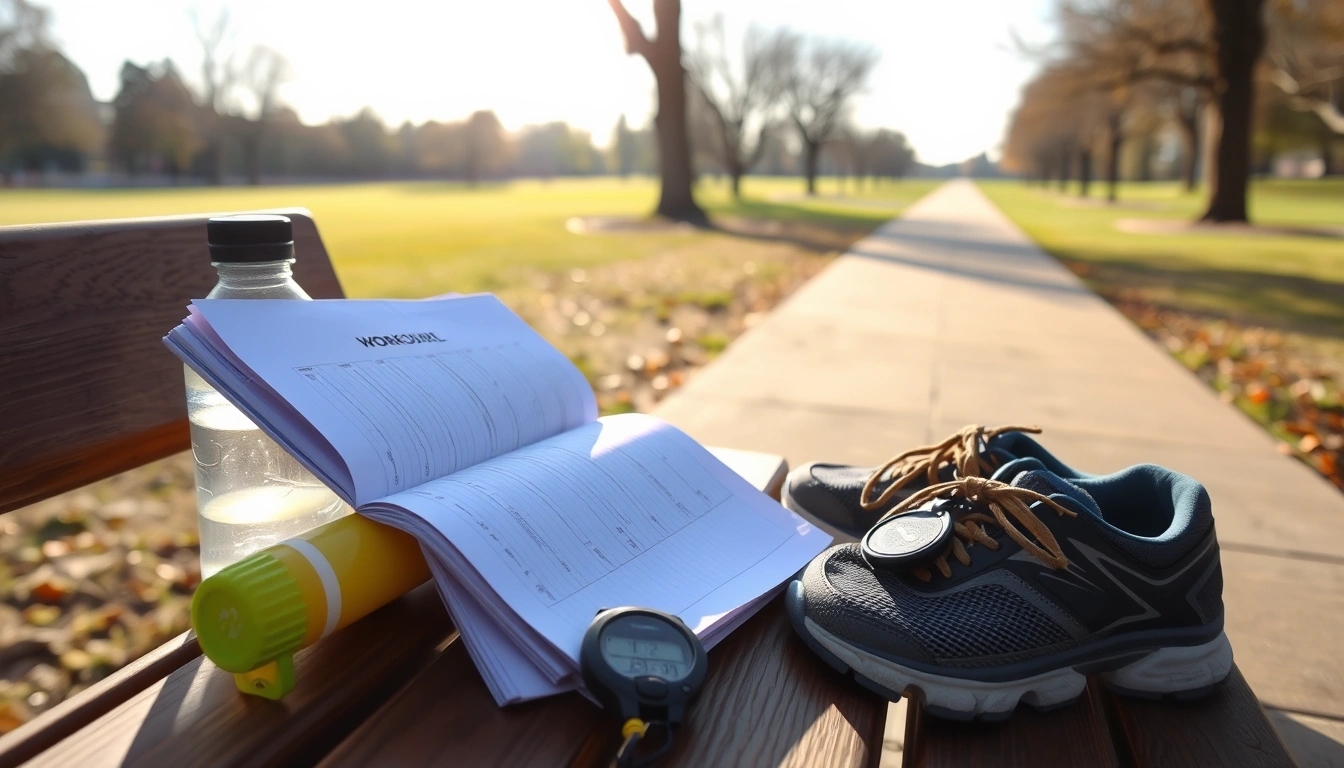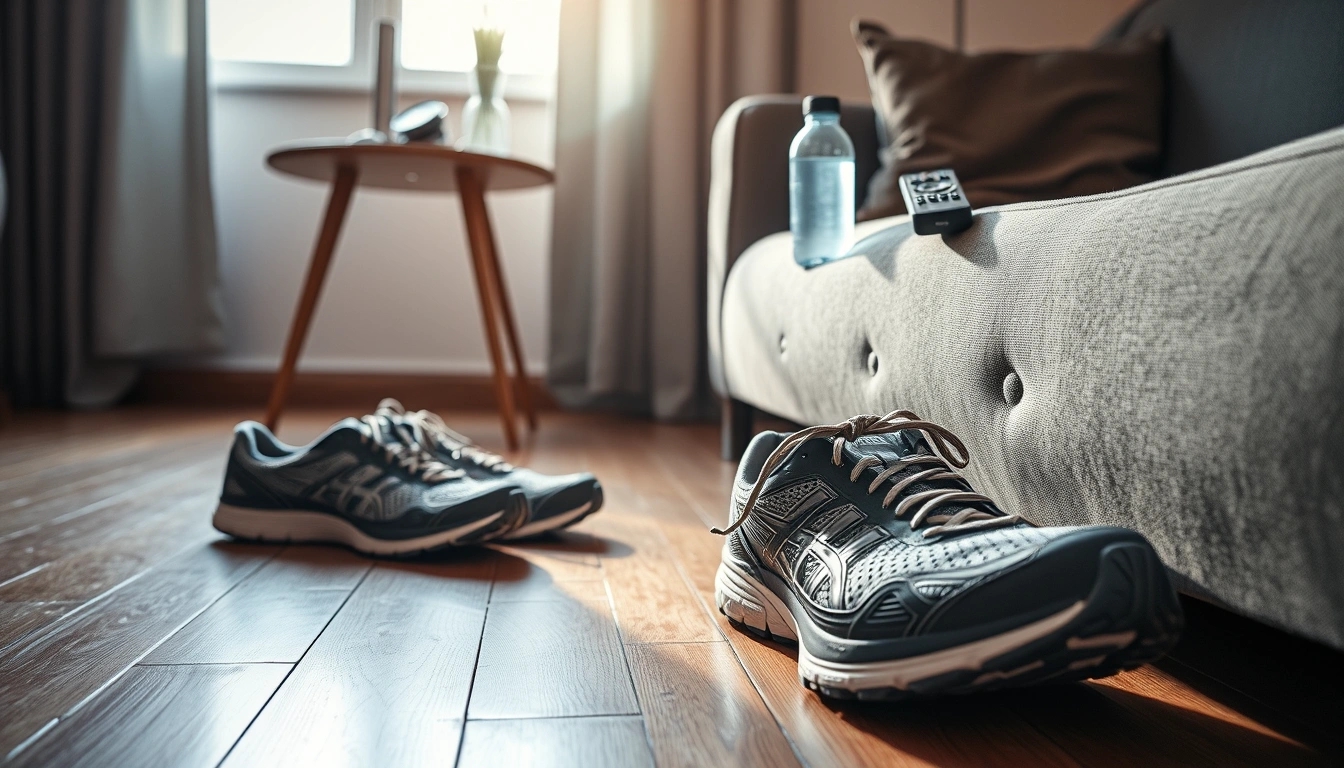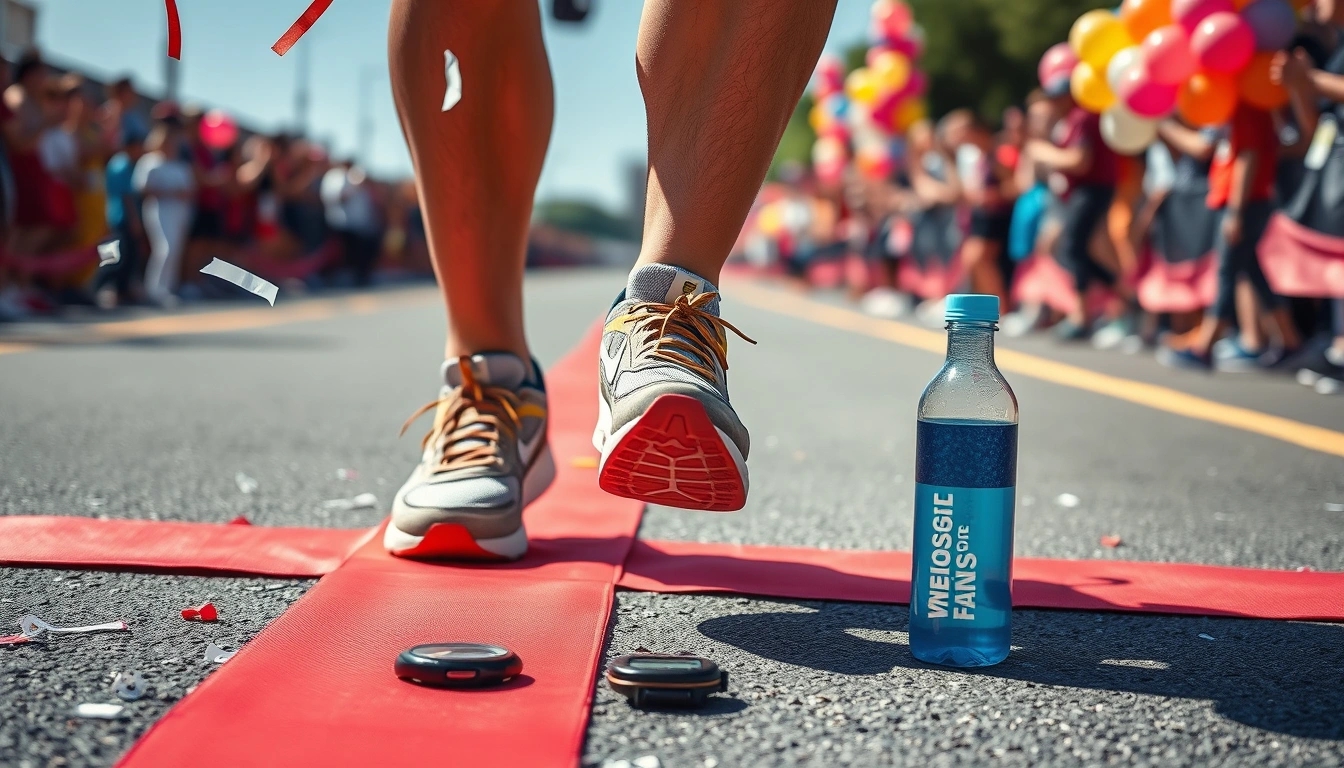Getting off that comfy couch and actually pounding the pavement? Yeah, it sounds way more intimidating than it really is. If you’re staring at your sneakers gathering dust, wondering how on earth you’ll manage a whole 5k run without turning into a gasping, wheezing mess, you’re not alone. The truth? Everyone starts somewhere, and this guide is here to walk (or jog) you through the basics without making you feel like you’ve lost your marbles.
First off, let’s ditch the idea that you need to be some sort of superhero athlete to start running. Spoiler alert: you don’t. The Couch to 5k program is basically a gentle nudge, helping you build stamina in baby steps. It’s like teaching your legs not to hate you, one slow jog at a time. No marathon dreams on day one, please. Setting realistic goals is key — because nothing kills motivation faster than biting off more than you can chew.
| Common Beginner Mistakes | How to Avoid Them |
|---|---|
| Trying to run too far too soon | Stick to a plan that alternates walking and running |
| Ignoring warm-ups and cool-downs | Spend 5-10 minutes warming up and cooling down to prevent injuries |
| Wearing the wrong shoes | Invest in good running shoes, but no need to break the bank |
| Skipping rest days | Rest is part of progress—listen to your body |
Now, gear talk. Do you really need those flashy, expensive gadgets? Nope. A decent pair of running shoes that fit well is your best friend. Clothes? Comfortable, breathable stuff will do — no need for full-on pro gear unless you want to impress your cat. And if you’re the type who loves tracking every heartbeat, step, and calorie, apps can be a fun way to keep tabs. But don’t get sucked into the data vortex—sometimes just remembering how you felt is enough.
- Warm-up tip: Walk briskly for 5 minutes before you start running.
- Cool-down tip: Slow down to a walk for 5 minutes after your run.
- Goal setting: Aim to run for 60 seconds, then walk for 90 seconds, repeat.
Look, motivation is a tricky beast. Some mornings you’ll feel like a rockstar, other days the couch will whisper sweet nothings and Netflix will win. That’s okay. Find a buddy, join a local running group, or even just shout your goals on social media for some accountability. And hey, celebrate every little win — finished week one? High five! Ran a full 5k? Throw a mini party (even if it’s just you and a slice of pizza).
Remember, running isn’t supposed to be torture. It’s a journey with ups, downs, and plenty of “why did I sign up for this?” moments. But stick with it, and you’ll surprise yourself. So get those shoes on, step outside, and start your Couch to 5k adventure — one awkward, breathless, but totally worth-it step at a time.
Why Choose Couch to 5k?
Alright, so you’re staring at your running shoes like they’re some alien artifact, wondering if you should just keep binge-watching instead of attempting to jog. Trust me, been there. That’s where the Couch to 5k program comes in like a friendly nudge rather than a drill sergeant yelling at you to “move it!”
This program isn’t about turning you into a marathon beast overnight. Nope, it’s designed specifically for folks who haven’t run since maybe chasing the ice cream truck as a kid. The magic? It’s a slow build-up — mixing walking and jogging intervals — so your body doesn’t throw in the towel or scream “why me?” after five minutes. You’re not just thrown into the deep end; you’re eased in like a cautious swimmer testing the water.
- Gentle Progression: The plan gradually ramps up your running time, which means you actually build endurance without feeling like a total wreck.
- Injury Prevention: Because let’s be honest, starting too fast is a one-way ticket to shin splints, knee pain, or worse. This program respects your joints and muscles.
- Motivation Boost: It’s structured, so you know exactly what to do each day. No guesswork, no “what now?” moments.
Now, some might say, “Why not just hit the gym or do a yoga class?” Sure, those are great, but the beauty of Couch to 5k is that it’s outdoors, simple, and requires zero fancy equipment. Just your shoes and some grit.
| Feature | Why It Matters |
|---|---|
| Interval Training | Alternating walking and running helps your body adapt gradually, reducing burnout. |
| Short Workouts | Sessions last about 20-30 minutes, perfect for busy schedules and avoiding overwhelm. |
| Community Support | Many apps and forums connect you with fellow beginners, making the journey less lonely. |
Let’s get real for a second: starting to run can be intimidating. You might be thinking, “I’m way too out of shape,” or “I’ll just embarrass myself.” But Couch to 5k flips that script by making it doable. It’s like having a coach in your pocket who gets that you’re not a superhero yet.
Plus, the program’s pacing means you’re less likely to burn out or get sidelined by injuries — a common rookie mistake. You actually get to enjoy the process, even if you’re huffing and puffing at first. And hey, celebrating those tiny wins (like running for a full minute without collapsing) keeps the motivation rolling.
- Pro Tip: Don’t sweat it if you miss a day or two. The program’s flexible enough to let you pick up where you left off without guilt.
- Heads Up: It’s normal to feel a bit sore or tired, but sharp pain? That’s your body waving a red flag — slow down or check in with a doc.
In the end, Couch to 5k isn’t just a running plan — it’s a mindset shift. From “I can’t even” to “Hey, I just did 5k!” It’s about turning “meh” into momentum, one step at a time.
So, if you’re ready to stop being a couch potato and start feeling like a runner (even if it’s a slow one), this program’s got your back.
Gear Up: What You Really Need
Alright, before you dash out the door with dreams of crushing your first 5k, let’s get real about what gear you actually need—and what’s just fluff that’ll drain your wallet faster than you can say “runner’s high.” Spoiler alert: you don’t need every shiny gadget or the fanciest shoes on the market to start running. Seriously, save that cash for post-run pizza.
Shoes: The Only Non-Negotiable
Listen, your feet are the MVPs here. You want shoes that fit well, offer decent support, and won’t turn your first run into a blister fest. No need to break the bank on the latest “space-age” sneakers. A good pair of running shoes from a reputable brand, ideally fitted at a specialty store, will do the trick. If you’re unsure, just avoid the super cheap ones—your feet will thank you later.
| Feature | Why It Matters | Budget Tip |
|---|---|---|
| Cushioning | Absorbs impact and protects joints | Look for mid-range shoes with foam soles |
| Fit | Prevents blisters and discomfort | Try shoes in the afternoon when feet are swollen |
| Durability | Lasts through training cycles | Rotate shoes every 300-500 miles |
Clothing: Comfort Over Style
Forget about looking runway-ready. Your clothes should be breathable, wick sweat, and let your skin breathe. Cotton? Nope, that’s a no-go. It traps moisture and turns into a soggy mess. Grab some polyester or nylon blends instead. Bonus points if your gear has reflective strips for those early morning or late evening runs. And hey, if you’re running in winter, layering is your best friend—think of it like an onion, peel off layers as you warm up.
- Essential: Moisture-wicking shirt and shorts/pants
- Nice to have: Lightweight jacket or hoodie
- Skip: Compression gear unless you’re into that kind of thing
Gadgets: Fun but Not a Must
Here’s where people tend to get sucked into the “must-have” vortex. GPS watches, heart rate monitors, fancy earbuds, running apps that track every heartbeat and calorie burned—it’s all cool but totally optional. If you’re just starting, your phone’s stopwatch or a simple timer will do just fine. Don’t let tech overwhelm you or make you feel like you’re not “serious” enough. Running is supposed to be fun, remember?
Practical Gadget Checklist:- Phone with a stopwatch app- Basic earbuds (if you like music)- Hydration bottle (optional but helpful)- Running belt (only if you need to carry stuff)
What You Can Totally Skip
Here’s a quick rundown of what you can safely ignore and still smash your Couch to 5k goals:
- Expensive energy gels and supplements (water and a balanced diet got you covered)
- High-end compression socks (unless you have specific needs)
- Fancy running sunglasses (unless you run in blazing sun daily)
- Personalized training plans from expensive coaches (there are tons of free resources)
So, to sum it all up: lace up with a decent pair of shoes, throw on some comfy, sweat-wicking clothes, grab your phone if you want, and hit the road. No need to overthink or overspend. Your wallet and your feet will both thank you.
Remember: Running is about progress, not perfection. Gear is just the background music to your journey—not the star of the show.

Setting Realistic Goals
Alright, so you’ve decided to kickstart your running journey with the Couch to 5k program — fantastic! But before you lace up and sprint out the door like you’re chasing the ice cream truck, let’s pump the brakes for a sec. Aiming for the moon on day one might sound inspiring, but honestly, it’s a fast track to burnout, frustration, and possibly some serious self-doubt. Trust me, nobody starts as a marathon champ, and expecting to run 5k nonstop right off the bat is like trying to binge-watch a whole season of a show on your first day of Netflix — overwhelming and kinda pointless.
Here’s the deal: setting small, achievable goals is the secret sauce to keeping your motivation high and your spirits from crashing faster than your phone battery at 1%. You want to feel like a champ after every session, not like you just survived a zombie apocalypse. So instead of “I’m gonna run 5k tomorrow,” start with “I’ll run for 1 minute, then walk for 2.” Baby steps, my friend.
| Goal Type | Example | Why It Works |
|---|---|---|
| Distance-Based | Run 500 meters without stopping | Clear, measurable, and gives a tangible target to hit |
| Time-Based | Run for 2 minutes, then walk for 3 | Focuses on effort and endurance, not speed |
| Consistency-Based | Exercise 3 times a week | Builds routine and discipline, which is half the battle |
Now, you might be thinking, “But I want results fast!” Sure, who doesn’t? Yet, rushing things is like trying to microwave a Thanksgiving turkey — it just ain’t gonna turn out right. When you set realistic goals, you avoid the common pitfall of overtraining and the soul-crushing disappointment of missing your own expectations. Plus, small wins add up. Celebrate those little victories — whether it’s running an extra minute or simply showing up on a day when Netflix was screaming your name. It all counts.
- Tip 1: Write your goals down. There’s something oddly motivating about seeing your targets in black and white.
- Tip 2: Adjust as you go. If a goal feels impossible, tweak it. This isn’t a test; it’s your journey.
- Tip 3: Share your goals with a friend or community. Accountability buddies are like the secret weapon of motivation.
And here’s a little nugget of wisdom: progress, not perfection, is what really matters. Some days you’ll feel like a gazelle, other days more like a sloth — and that’s perfectly okay. The key is to keep moving forward, even if it’s just a shuffle.
Remember:- Start small- Celebrate wins- Adjust goals- Keep consistent- Don’t beat yourself up
So yeah, don’t aim for the moon on day one. Instead, set your sights on the next lamppost, then the next, and before you know it, you’ll be running circles around your old self — frustration-free and fueled by confidence.
Happy running!
Warm-ups and Cool-downs: Not Just for Pros
Skipping warm-ups? Rookie mistake. Seriously, if you think you can just jump out the door and start pounding the pavement without prepping your muscles, you’re in for a rude awakening. Warming up isn’t some fancy ritual reserved for elite athletes—it’s a game changer for anyone lacing up their running shoes, especially if you’re just starting out. Your muscles are like a car engine: cold starts lead to sputters and stalls, but a bit of gradual revving smooths everything out.
Let’s break it down. When you warm up, you’re gently increasing your heart rate and blood flow, which means oxygen and nutrients get delivered to your muscles faster. This reduces stiffness and lowers the risk of strains or pulls. Plus, it wakes up your nervous system so your coordination doesn’t resemble a newborn giraffe trying to walk. And don’t get me started on the mental side—warming up gives you a chance to switch gears from couch potato mode to “I got this” mode.
| Warm-up Benefits | Cool-down Benefits |
|---|---|
| Increases muscle temperature | Gradually lowers heart rate |
| Improves joint mobility | Prevents blood pooling |
| Enhances performance | Reduces muscle soreness |
| Prevents injuries | Promotes recovery |
Now, cooling down might seem like an afterthought, but it’s just as crucial. Imagine you’ve just sprinted like a madman or jogged your first mile—your heart is pounding, blood is rushing, and your muscles are screaming for mercy. Suddenly stopping cold turkey? Not cool. Cooling down lets your body gradually return to its resting state, preventing dizziness, and more importantly, flushing out metabolic waste like lactic acid that builds up during exercise.
- Warm-up ideas: light jogging, dynamic stretches (think leg swings, arm circles), or brisk walking for 5-10 minutes.
- Cool-down tips: slow jogging or walking, followed by static stretching focusing on calves, hamstrings, and quads.
Here’s a simple routine you can try before and after your runs:
Warm-up (7 minutes total):- 3 minutes brisk walk- 2 minutes leg swings (10 each leg)- 2 minutes arm circles and lungesCool-down (8 minutes total):- 4 minutes slow walk- 4 minutes static stretches (hold each stretch 20-30 seconds)
Look, I get it—sometimes you’re in a rush or just itching to get the run over with. But skipping these steps is like trying to bake a cake without preheating the oven. It might work, but it’s messy and disappointing. So next time you’re tempted to blow off your warm-up or cool-down, remember: your muscles and sanity will thank you later.
In a nutshell? Don’t be that person who shows up to the running party unprepared. Take the time to warm up and cool down properly. Your body isn’t just a machine; it’s a complex system that needs a little TLC before and after you test its limits. Trust me, your future self—who’s still able to walk without wincing—will appreciate it.
Sample Week 1 Plan
Alright, so you’ve decided to ditch the couch and actually move those legs—kudos! But before you go full beast mode and sprint like you’re chasing the ice cream truck, let’s pump the brakes a bit. The first week of your Couch to 5k journey is all about finding balance, mixing walking and running in a way that doesn’t leave you gasping for air after five minutes. Trust me, nobody wants to be that person wheezing on the sidewalk, looking like they just survived a zombie apocalypse.
Here’s the deal: the goal isn’t to run a marathon in your first week but to ease your body into the rhythm. Think of it like a dance—you gotta learn the steps before you bust out the moonwalk. Your muscles, lungs, and even your brain need time to get used to this new “running” business.
| Day | Activity | Duration | Notes |
|---|---|---|---|
| Day 1 | Brisk Walk + Easy Jog Intervals | 20 minutes (1 min jog / 1.5 min walk repeats) | Focus on breathing, don’t sprint! |
| Day 2 | Rest or Light Stretching | — | Muscle recovery is key |
| Day 3 | Walk/Jog Intervals | 20 minutes (1.5 min jog / 2 min walk repeats) | Keep it comfortable, no hero moves |
| Day 4 | Rest | — | Seriously, rest up! |
| Day 5 | Walk/Jog Intervals | 25 minutes (2 min jog / 2 min walk repeats) | Try to enjoy the rhythm |
| Day 6 | Active Recovery (Light walk or yoga) | 20 minutes | Keep those muscles loose |
| Day 7 | Rest | — | Celebrate making it through week 1! |
See? Nothing too crazy. The key here is alternating walking and jogging so your body gradually adapts. Don’t feel bad if you’re walking more than running—that’s the whole point! You’re building stamina, not breaking records. Plus, this approach slashes the risk of injury, which is a total buzzkill when you’re just starting.
- Pro tip: Use a stopwatch or a running app to keep track of your intervals. It’ll help you stick to the plan without constantly checking your watch.
- Another thing: Focus on good posture. Keep your shoulders relaxed and avoid overstriding (that’s when your foot lands too far ahead, causing extra strain).
- And hey: Don’t forget to hydrate before and after your sessions. Water is your best friend here.
Just a heads up: your first week might feel a bit awkward. Your legs may complain, your lungs might throw a tantrum, and your brain could question your sanity. That’s normal! Stick with it, and by week two, you’ll probably start feeling like a legit runner (or at least less like a gasping goldfish).
Remember:- Patience is your secret weapon.- Walking is NOT cheating.- Listen to your body; if something hurts (not the usual burn), pause and assess.
So, lace up, hit the pavement, and keep your expectations real. You’re not just running; you’re building a habit, a healthier lifestyle, and trust me, it’s worth every awkward first step.
Ready to tackle week one? Let’s do this!

Tracking Your Progress
So, you’ve decided to start running, and now comes the part where you try to remember how far you went, how fast you were, or if you even ran at all yesterday. Tracking your runs can be a lifesaver—or a total headache, depending on how you go about it. The question is: should you dive into apps, scribble in journals, or just trust your memory? Let’s unpack this without turning you into a “data zombie” obsessing over every step.
- Apps: The Double-Edged Sword
Apps like Strava, Nike Run Club, or Garmin Connect are pretty much the reigning champs of run tracking. They give you GPS routes, pace, calories burned, and sometimes even a pat on the back. But here’s the kicker: they can also make you paranoid about every second you lose or every meter less you run. If you’re not careful, you might start running for the app, not for yourself. Plus, battery drain and phone glitches can be a real pain mid-run.
- Journals: Old School but Gold School
If you’re the kind who loves pen and paper (or just wants to avoid screen time), a running journal might be your best friend. It’s simple: jot down your distance, how you felt, weather conditions, and maybe a little note like “legs felt like jelly” or “crushed it today!” This method keeps it personal and flexible, but hey, it relies on you remembering to write stuff down. And sometimes, you’ll forget. Happens to the best of us.
| Tracking Method | Pros | Cons |
|---|---|---|
| Apps | Accurate data, social features, progress graphs | Can be distracting, battery use, over-dependence on tech |
| Journals | Personalized notes, low tech, encourages reflection | Requires discipline, less precise data, easy to forget |
| Memory | Zero effort, spontaneous | Highly unreliable, no data for improvement |
Now, if you’re thinking, “Why not both?”—you’re onto something. Some runners use apps for hard data and journals for feelings and lessons learned. It’s like having your cake and eating it too, without getting stuck in a spreadsheet.
Tips for Balanced Tracking:- Use apps for distance and pace.- Write quick notes after runs about how you felt.- Don’t obsess over every tiny detail.- Review your journal weekly to spot patterns.
Here’s a little secret: tracking is meant to help, not stress you out. If you start feeling like your run is just a data point, take a step back. Remember, the goal is to enjoy moving, not to become a slave to numbers.
In the end, whether you’re a tech geek or a pen-and-paper purist, the best way to track your progress is the one that keeps you coming back for more runs, not less. So pick your weapon—app, journal, or trusty memory—and get out there. Your future 5k self will thank you.
Nutrition Tips for Beginners
Alright, let’s get one thing straight: fueling your body right isn’t about munching kale 24/7 or surviving on carrot sticks and celery juice. Nope, it’s way more practical (and honestly, way more delicious) than that. If you’re just starting your Couch to 5k journey, what you eat before and after your runs can seriously impact how you feel, how you perform, and how quickly you recover. So, buckle up, because here’s the real deal on nutrition for beginners.
Before Your Run: Keep It Light, Keep It Smart
Running on a full stomach? Bad idea. Running on an empty stomach? Also not great, unless you’re into feeling like a zombie. The trick is to eat something that gives you energy but won’t weigh you down. Think simple carbs and a little protein. For example:
- A banana with a spoonful of peanut butter
- A slice of toast with honey
- A small bowl of oatmeal with some berries
Try to eat about 30 to 60 minutes before you hit the pavement. If you’re running early and breakfast feels like a no-go, a quick snack can save your butt.
After Your Run: Time to Refuel and Repair
Post-run meals are like your body’s way of saying “thanks for the workout.” You want to replenish glycogen (energy stores) and repair muscles with protein. Here’s a simple breakdown:
| What to Eat | Why |
|---|---|
| Lean protein (chicken, tofu, eggs) | Muscle repair and recovery |
| Complex carbs (brown rice, sweet potatoes) | Restore energy |
| Veggies (spinach, broccoli) | Vitamins and minerals |
| Hydration (water, electrolyte drinks) | Replace fluids lost through sweat |
Don’t stress about the perfect meal right away. Even a smoothie with protein powder and fruit can do the trick if you’re in a rush.
Quick Tips to Keep in Mind:
- Hydrate, hydrate, hydrate. Water is your best friend before, during, and after running.
- Don’t experiment on race day. Stick to foods you know won’t upset your stomach.
- Listen to your body. Craving carbs? Go for it. Feeling sluggish? Maybe up your protein.
- Balance is key. No need to be a nutrition ninja; just aim for variety and moderation.
Look, nobody’s perfect, and your diet won’t be either. But if you keep these practical tips in mind, you’ll be fueling your runs like a pro in no time — without turning into a rabbit nibbling on kale all day. So, grab that banana, lace up, and get moving! Your body will thank you.
Common Mistakes to Avoid
Jumping into running without a clue can be a bit like trying to assemble IKEA furniture blindfolded — you might get there eventually, but expect some bruises and a lot of head-scratching along the way. When you’re just starting out on your Couch to 5k journey, there are some classic pitfalls that newbies tend to trip over. Let’s unpack these traps and, more importantly, how to dodge them like a pro.
1. Overtraining: The Fast Track to Burnout
Listen, enthusiasm is great. But trying to run five days a week when you barely made it through week one? Rookie move. Your body needs time to adapt. Overtraining leads to fatigue, nagging injuries, and can crush your motivation faster than you can say “I quit.” Aim for balance — mix running with rest or low-impact activities like walking or yoga. Remember, progress is a marathon, not a sprint.
| Common Mistake | Why It’s a Problem | How to Avoid |
|---|---|---|
| Ignoring Pain | Can turn minor aches into serious injuries | Listen to your body; rest or see a professional if pain persists |
| Skipping Warm-ups | Increases injury risk and muscle stiffness | Spend 5-10 minutes warming up with light cardio and dynamic stretches |
| Setting Unrealistic Goals | Leads to frustration and quitting | Set small, achievable targets and celebrate wins |
2. Ignoring Pain: The ‘No Pain, No Gain’ Myth
Here’s a truth bomb: pain is your body’s way of waving a red flag. That nagging knee ache or sharp calf pain? Don’t just “run it off.” Pushing through serious pain can spiral into injuries that bench you for weeks, or worse. If something hurts, take a break, ice it, stretch gently, or seek advice. Trust me, your future self will thank you.
3. Neglecting Warm-ups and Cool-downs
Skipping warm-ups because you’re “too cool” or in a rush? That’s a shortcut to muscle cramps and strains. Spending just a few minutes on light jogging or brisk walking, followed by dynamic stretches, preps your muscles for action. And don’t forget cooldowns! They help flush out lactic acid and reduce soreness. Think of warm-ups and cool-downs as your workout’s unsung heroes.
- Warm-up ideas: 5 minutes brisk walk, leg swings, arm circles
- Cooldown tips: Slow jog or walk for 5 minutes, followed by static stretching
4. Unrealistic Goal Setting
If your first goal is to run a sub-20-minute 5k after a lifetime on the couch, you’re setting yourself up for disappointment. It’s better to break down your journey into bite-sized chunks. For example, aim to run for 60 seconds without stopping, then 90 seconds, and so on. Celebrate these small victories — they keep the fire alive.
5. Poor Footwear Choices
Yes, those flashy sneakers look cool, but if they don’t fit or support your feet properly, you’re asking for trouble. Invest in a decent pair of running shoes that suit your foot type and running style. Most specialty stores offer gait analysis and fitting services — use them.
Quick Checklist to Avoid Common Mistakes:- Listen to your body; don’t push through sharp pain- Warm up & cool down every session- Gradually increase intensity and distance- Set realistic, incremental goals- Wear proper running shoes- Rest days are just as important as run days
In the end, running your first 5k isn’t about being perfect — it’s about showing up, learning, and adapting. Slip-ups will happen, but with a bit of patience and some street-smart strategies, you’ll sidestep these common traps and cross that finish line with a grin. So lace up, take it easy, and remember: even the pros started somewhere.

Staying Motivated When You’d Rather Netflix
Let’s be honest — sometimes the couch *wins*. You’ve got your running shoes ready, the sun’s shining, but your brain’s screaming, “Nah, let’s binge-watch that new series instead.” Happens to the best of us. Motivation is a sneaky beast, especially when Netflix’s siren call is loud and clear. But hey, don’t beat yourself up just yet. Here’s the real talk on how to keep your eyes on the prize when your comfy sofa looks way comfier than the track.
First off, remember why you started. It sounds cliché, but having a clear reason — whether it’s shedding some pounds, beating your own time, or just feeling healthier — can be a game-changer. Write it down, stick it somewhere visible. Heck, slap a sticky note on your TV remote if that helps. When the couch whispers sweet nothings, your reminder can shout louder.
- Set micro-goals: Don’t think about running 5k straight away. Aim for just 5 minutes today, then 7 tomorrow. Small wins build momentum.
- Mix it up: Running the same route every day? Snooze fest. Try new paths, or even throw in some music or podcasts that pump you up.
- Reward yourself: No, not with a donut (well, maybe once in a while). Treat yourself to a movie night, new running gear, or a fancy smoothie after a solid run.
| Common Motivation Killers | How to Fight Back |
|---|---|
| Feeling too tired after work | Try morning runs or quick 10-minute jogs instead of long sessions |
| Weather’s awful (rain, snow, heatwave) | Invest in weather-appropriate gear or shift to indoor cardio on bad days |
| Running feels boring | Join a local running group or try interval training to spice things up |
Now, here’s a little secret — motivation isn’t a constant flame. It flickers, dies down, and sometimes disappears altogether. That’s perfectly normal. The trick isn’t to always feel like a superhero but to build habits that keep you moving even when motivation’s MIA. Ever heard of the “5-minute rule”? Tell yourself you’ll just run for 5 minutes. Usually, once you’re out there, you’ll keep going. Or not, and that’s okay too. Progress over perfection, remember?
Accountability buddies are another lifesaver. Find a friend, join an online forum, or even post your progress on social media. Knowing someone’s watching (or cheering) can push you off the couch faster than any pep talk.
Pro Tips to Stay Motivated:- Lay out your running clothes the night before.- Track your runs with apps that celebrate your milestones.- Switch up playlists or podcasts to keep things fresh.- Celebrate every run, no matter how small.
At the end of the day, don’t be too hard on yourself if you skip a day or two. Life happens. Just don’t let the couch win for good. Remember, every step, even the slow or reluctant ones, get you closer to your goal. So, next time you’re torn between the track and the TV, think about how awesome you’ll feel crossing that finish line — way better than finishing a Netflix series in one sitting, right?
Keep your eyes on the prize, and the couch will have to wait.
Injury Prevention and When to See a Doctor
Running—oh, the sweet agony of pounding the pavement! It’s thrilling, exhausting, and yeah, sometimes downright painful. But here’s the million-dollar question: when does that ache in your leg mean you’re just sore, and when is it a big, flashing red flag screaming, “Hey buddy, slow down!”? Let’s dive in before you hobble off into the sunset with a stress fracture.
First off, not all pain is created equal. Soreness? That’s the “I pushed myself” kind of pain. It usually hits a day or two after your run and feels like your muscles are politely reminding you they exist. This is normal, even kinda satisfying if you’re into that post-workout ache. But if the pain is sharp, stabbing, or sticks around like an unwelcome guest, that’s when you need to pay attention.
- Muscle soreness: Dull, spread out, fades with gentle stretching and rest.
- Injury pain: Sharp, localized, sometimes swelling or bruising shows up.
- Joint pain: Could mean inflammation or something more serious like tendonitis or bursitis.
Now, prevention is the name of the game. Here’s a quick table to keep your running routine injury-proof-ish (because, let’s be honest, life happens):
| Tip | Why It Matters | Quick Fix |
|---|---|---|
| Proper Shoes | Bad shoes bad knees and ankles | Get fitted at a specialty store, replace every 300-500 miles |
| Warm-up & Cool-down | Prevents muscle tears and stiffness | 5-10 mins of light jogging + stretching |
| Gradual Progression | Avoids overtraining injuries | Increase mileage by no more than 10% per week |
| Listen to Your Body | Stops minor aches from becoming major issues | Rest or cross-train when in doubt |
But hey, sometimes you gotta know when to wave the white flag and see a pro. Here’s the no-nonsense checklist for booking that doctor’s appointment:
- Persistent pain lasting more than two weeks despite rest
- Swelling, redness, or warmth around a joint
- Sharp, stabbing pain during or immediately after running
- Numbness or tingling sensations
- Inability to bear weight or limp severely
Ignoring these signs is like ignoring a smoke alarm because you’re in a hurry—bad idea. Early diagnosis can save you weeks, maybe months, of misery.
Finally, let’s not forget the mental side of injury prevention. Running through pain because you’re “tough” is just stubbornness wearing running shoes. Your body’s smarter than you think, and sometimes it needs a break to come back stronger.
So, in short: soreness? Cool, you’re making progress. Sharp pain? Time to back off and maybe get checked out. And prevention? It’s your best friend—treat it like your running buddy who’s always got your back.
Remember, running should hurt your lungs, not your joints. Happy running, and may your only red flags be the ones at the finish line!
Joining a Community: Why It Helps
Running alone can sometimes feel like you’re shouting into the void. Sure, it’s peaceful and you get to zone out to your favorite tunes or podcasts, but let’s be honest—solo runs can get pretty lonely, and motivation? Well, it tends to take a nosedive after a while. That’s where joining a community steps in like a trusty sidekick, ready to boost your morale and push your performance to new heights.
- Accountability is king. When you’re part of a running group or club, suddenly that 6 AM run isn’t just a suggestion anymore—it’s a commitment. You don’t want to be the one who flakes out, right? Having buddies waiting for you at the start line can make all the difference between hitting snooze and hitting the pavement.
- Shared experiences make the journey sweeter. Whether you’re celebrating a new personal best or complaining about sore calves, doing it with others who get it feels way better. Plus, swapping tips about gear, routes, or nutrition? Priceless.
| Community Type | Benefits | Potential Downsides |
|---|---|---|
| Local Running Clubs | Face-to-face interaction, organized runs, social events | Schedule conflicts, sometimes intimidating for beginners |
| Online Forums & Social Media Groups | 24/7 support, diverse advice, flexible participation | Lack of physical presence, info overload |
| Virtual Running Challenges | Motivation through gamification, global community | Can feel impersonal, requires self-discipline |
Now, if you’re thinking, “But I’m shy, or I don’t know where to start,” no worries. Online forums and social media groups are a fantastic way to dip your toes in the water without the awkwardness of face-to-face meetups. Places like Reddit’s r/running or Facebook groups dedicated to beginners offer heaps of encouragement and advice. Plus, no one’s judging your pace or your choice of running shoes.
Pro tip: Try mixing it up. Join a local club for the occasional group run and stay active online for daily motivation. That way, you get the best of both worlds—real-life camaraderie and constant digital cheerleading.
- Boosts mental health: Running with others can reduce stress and anxiety. It’s not just about the physical sweat but the emotional lift.
- Improves performance: Friendly competition and group energy often push you to run faster or longer than you would solo.
- Creates lasting friendships: You might just find your new running squad or even a lifelong buddy.
Of course, communities aren’t perfect. Sometimes personalities clash or schedules don’t align. But hey, that’s life. The key is to find a group that vibes with you and your goals. Remember, running is supposed to be fun—not a chore or a social nightmare.
So, next time you’re tempted to skip your run because “meh, it’s just me,” consider reaching out. Whether it’s a quick message in a forum or showing up at a local park run, connecting with others can turn your Couch to 5k journey from a solo slog into a shared adventure.
In summary:
| Why join a running community? | Accountability, motivation, shared knowledge, emotional support, improved performance |
| Where to find communities? | Local clubs, online forums, social media groups, virtual challenges |
| How to get started? | Start small, join a beginner-friendly group, mix online and offline participation |
Running may be an individual sport, but that doesn’t mean you have to go it alone. Sometimes, the best way forward is with a pack by your side.

Celebrating Your 5k Finish Line
So, you’ve finally done it — crossed that finish line after weeks (or months) of sweating, panting, and questioning your life choices. First off, congratulations! Seriously, that’s no small feat. But here’s the kicker: finishing your first 5k isn’t the end of the road; it’s just the start of a whole new journey. Now that you’ve tasted victory, how do you keep that fire burning without turning into a couch potato again? Let’s dive into some fun, practical, and maybe slightly unconventional ideas to celebrate and set your next goal without losing steam.
First things first, take a moment to celebrate properly. This isn’t just about a pat on the back; it’s about recognizing your hard work and giving yourself some well-earned credit. Throw a mini party, order your favorite cheat meal (yes, that triple chocolate cake counts), or even treat yourself to a shiny new pair of running shoes. Trust me, having fresh gear can be a sneaky motivator. Feeling fancy? Snap a victory selfie and flood your socials with it — nothing like some digital high-fives to boost your ego.
| Celebration Idea | Why It Works | Bonus Tip |
|---|---|---|
| Host a post-run brunch | Good food + friends happiness overload | Include some protein to help muscles recover |
| Get a massage or foam roll session | Relaxes tired muscles and feels like a mini-spa day | Try a DIY foam rolling if professional massage isn’t an option |
| Buy new running gear | Fresh gear sparks fresh motivation | Look for sales; you don’t need to break the bank |
| Sign up for your next race | Having a date keeps your training on track | Choose a race with a vibe you’ll love, like a charity run |
| Join a running group or club | Community keeps you accountable and makes running fun | Try different groups to find your tribe |
Alright, now that you’re basking in your glory, let’s talk about setting your next goal. It’s tempting to jump straight into training for a marathon or some ultra-marathon nonsense (who even runs 50k for fun?), but slow your roll. The key is to build on your momentum without burning out or getting sidelined by injuries. Maybe aim for a faster 5k time, or try a 10k if you’re feeling adventurous. Heck, even committing to running three times a week consistently is a solid goal.
- Celebrate milestones: Break your big goal into smaller chunks—like shaving off 30 seconds from your 5k time every month.
- Mix it up: Add cross-training days with cycling or swimming to keep things fresh and avoid boredom.
- Listen to your body: If your knees scream louder than your playlist, it’s okay to rest or scale back.
And hey, don’t beat yourself up if motivation dips. It happens to the best of us. The trick is to keep that spark alive by mixing celebration with sensible goal-setting. Remember, the finish line is just a checkpoint, not the whole race. So, lace up, celebrate hard, and then get ready to crush whatever comes next.
Frequently Asked Questions
- What exactly is the Couch to 5k program?
Think of it as your personal running coach in your pocket. Couch to 5k is a beginner-friendly training plan designed to take you from zero to running a 5k in just a few weeks. It mixes walking and running intervals to build your stamina gradually, so you don’t feel like you’re climbing Everest on day one.
- Do I need special gear to start running?
Not really! While a good pair of running shoes is a must to protect your feet and joints, you don’t need fancy gadgets or expensive clothes. Comfortable, breathable clothing and a decent pair of sneakers are enough to get you moving without breaking the bank.
- How often should I run during the Couch to 5k program?
Consistency beats intensity here. Typically, running three days a week with rest or light activity days in between helps your body recover and adapt. Remember, it’s about building a habit, not burning out in a week.
- What if I feel pain during my runs?
Listen to your body! Mild soreness is normal, but sharp or persistent pain is a red flag. Take a break, ice the area, and if the pain sticks around, consult a healthcare professional. Injuries can sneak up if you ignore the signals.
- How can I stay motivated when I’d rather binge-watch TV?
We’ve all been there! Try setting small rewards, running with friends, or mixing up your routes to keep things fresh. Remember, every step forward is a win, and the feeling after a run? Totally worth it.
- Is tracking my progress really necessary?
Tracking isn’t mandatory, but it’s like having a scoreboard for your efforts. Whether it’s a simple journal, an app, or even a calendar check-off, monitoring your progress helps you see how far you’ve come and keeps motivation high.
- What should I eat before and after running?
No need to turn into a kale fanatic overnight. A light snack with carbs and a bit of protein before running fuels your energy, while a balanced meal afterward helps your muscles recover. Hydration is key too—don’t forget to drink water!
- Can I join a running community if I’m a total beginner?
Absolutely! Running groups and online forums are gold mines for support, advice, and motivation. Plus, sharing your journey makes it way more fun and keeps you accountable.
- What’s the best way to warm up and cool down?
Simple dynamic stretches and brisk walking before your run wake up your muscles, while gentle stretching and slow walking afterward help prevent soreness. Think of it as telling your body, “Hey, we’re about to move!” and then, “Good job, time to chill.”
- How do I celebrate finishing my first 5k?
Celebrate like a champ! Whether it’s treating yourself to your favorite meal, sharing your success with friends, or setting a new goal, acknowledging your achievement fuels your next adventure. Crossing that finish line is just the start of your running story.












